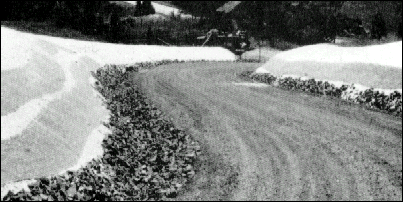
|

|
To Print Use The pdf File
ILLINOIS URBAN MANUAL
PRACTICE STANDARD
CONSTRUCTION ROAD STABILIZATION
(Feet)
Code 806
 (Source:VA Erosion and Sediment Control Handbook) |
DEFINITION
The stabilization of temporary construction access routes, subdivision roads, on-site vehicle transportation routes, and construction parking areas with stone immediately after grading.
PURPOSE
The purpose of this practice is to reduce erosion of temporary roadbeds and parking areas by construction traffic during wet weather.
CONDITIONS WHERE PRACTICE APPLIES
Wherever stone base roads or parking areas are constructed for use by construction traffic.
CRITERIA
Construction roads shall follow the contour of the natural terrain to the extent possible. The maximum grade is 10%.
Locate parking areas on naturally flat areas if they are available to minimize grading. Keep grades sufficient for drainage but not more than 4 %.
Construction roads shall be at least 14 feet wide for one-way traffic and 20 feet wide for two-way traffic. Two-way traffic widths shall be increased a minimum of 4 feet for trailer traffic. The type of vehicle or equipment, speed, loads, climatic and other conditions under which vehicles and equipment are expected to operate need to be considered and the minimum widths increased accordingly.
All cut and fill slopes shall be 2:1 (horizontal to vertical) or flatter.
Roadside ditches shall be provided as needed and shall be designed and constructed in accordance with practice standard GRASSED LINED CHANNEL 840.
The roadbed or parking surface shall be cleared of all vegetation, roots and other objectionable material.
Where seepage areas or seasonally wet areas must be crossed, install subsurface drains and geotextile filter fabric. Subsurface drains shall be installed in accordance with practice standard SUBSURFACE DRAIN 945. Geotextile filter fabric, which is used to minimize the migration of stone into the underlying soil by heavy vehicle loads, shall meet the requirements of material specification 592 GEOTEXTILE Table 1 or 2, Class I, II or IV.
At a minimum a 6 inch course of coarse aggregate meeting IDOT CA-1, CA-2, CA-3 or CA-4 gradation shall be applied immediately after grading or the completion of utility installation within the right-of-way.
All roadside ditches, cuts, fills, and disturbed areas adjacent to parking areas shall be stabilized in accordance with practice standards PERMANENT VEGETATION 880 or TEMPORARY SEEDING 965, as applicable.
CONSIDERATIONS
Improperly planned and maintained roads can become a continual erosion problem. Excess runoff from roads cause erosion in adjacent areas, and an unstabilized road may become a dust problem. Construction vehicle traffic routes are especially susceptible to erosion because they become compacted and collect and convey runoff along their surfaces. Rills, gullies and troublesome muddy areas form unless the road is stabilized.
During wet weather, unstabilized dirt roads may become so muddy they are virtually unusable, generating sediment and causing work interruption. Proper grading and stabilization of construction routes often saves money for the contractor by improving the overall efficiency of the construction operation while reducing the erosion problem.
Low-grade asphalt or asphalt grindings may be used to facilitate maintenance and removal of tracked earth.
Filter fabric may be used under the coarse aggregate to provide a stable foundation and to facilitate removal of the stone.
PLANS AND SPECIFICATIONS
Plans and specifications for installing construction road stabilization shall be in keeping with this standard and shall describe the requirements for applying the practice to achieve its intended purpose. At a minimum include the following:
1. Location where the practice will be installed
2. Dimensions of the practice - length, width and thickness
3. Alignment and grade of the practice
4. Type of materials
All plans shall include installation, inspection, and maintenance schedules with the responsible party identified.
Standard drawing CONSTRUCTION ROAD STABILIZATION IL-506 may be used as the plan sheet.
OPERATION AND MAINTENANCE
Inspect the condition of the surface of construction roads and parking areas. Construction roads quickly accumulate a layer of earth tracked by vehicular traffic that is a source of airborne dust. Periodic blading of the accumulated earth and top-dressing with new stone will be necessary.
Inspect seeded areas adjacent to the roads and parking areas to ensure that a vigorous stand of vegetation is maintained and inspect roadside ditches and other drainage structures to ensure that they do not become clogged with silt or other debris.
REFERENCES
Illinois Department of Transportation, 1997. Standard Specifications for Road and Bridge Construction. IL
Virginia Department of Conservation and Recreation, Division of Soil and Water Conservation, 1992. Virginia Erosion and Sediment Control Handbook, 3rd ed., VA
NRCS IL January 1999